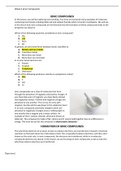Exam (elaborations)
CHEM 120 Week 2 Ionic Compound Q/A 98%
- Course
- Institution
IONIC COMPOUNDS In this lesson, you will be exploring ionic bonding. You have encountered many examples of molecules containing Ionic bonds including table salt and sodium fluoride which is found in toothpaste. We will see in this lesson how ionic compounds are formed and how the formation of thes...
[Show more]



